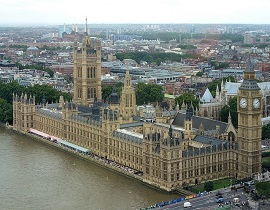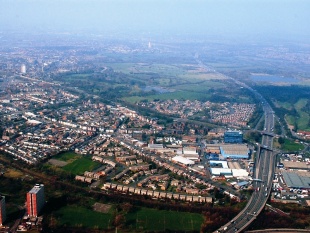A new capital for the UK
Relocating the British capital out of London would regenerate the regions, save money, and perhaps even rescue the UK itself, writes architect James Dunnett.
The mother of parliaments is in a parlous condition, physically if not democratically. The price of refurbishing the Palace of Westminster, the seat of the British Government in London, has been quoted at around an eye-watering £3 billion.
Unsurprisingly, the question of relocation has been raised – and not for the first time. To mark the centenary of the proclamation moving the capital of British India from Calcutta to Delhi, I suggested that Britain might contemplate a similar move itself. This would be a means to counter effectively the spiraling drain of wealth and economic activity to the south-east corner of the country, and also to respond to growing separatist political movements by establishing a capital for the UK that was shared equally, being more geographically central. The suggestion was not that a new city be built on a green-field site, but that it be planted in a decayed urban area to give form and hope.
I proposed West Bromwich as a possible starting point for the search of such a site, being at the hub of the motorway network and with its high street having had among the highest vacancy rates in the country.
In the past several years, these considerations have become stronger – the disparity in income and property values between London and the rest of the country has continued to grow, as has support for separatist parties – and a further factor has been added, relatively minor in economic scale even if major in symbolic value: the £3 billion price tag (the Government has started a search for architects to convert temporarily an existing building nearby for use by Parliament while the projected five-year refurbishment takes place). This third factor in particular has prompted influential pundits such as National Trust Chair Simon Jenkins and Ian Jack to speculate that possibly Parliament should be relocated elsewhere, perhaps in the north of England.
‘Nothing would do more to correct the metropolitan centralism of modern government’, writes Jenkins. ‘A regional move would reassert parliament as a popular congress of a united kingdom. It would be a gathering of the commons, not a colloquium of elites.’
But the conversation is always framed as a temporary, rather than a permanent move of the capital. During these four years some politicians have also spoken about the urgent need to ‘rebalance the economy’ in regional terms (Michael Heseltine), or proposed moving just the House of Lords to Leeds (Lord Adonis).
By contrast to these tentative proposals, the Egyptian Government announced in March 2015 its intention to build in as little as five to seven years ‘a brand new capital city …in undeveloped desert east of Cairo …with a new airport …Its main function would be to house government departments, ministries, and foreign embassies.’ This new city, being planned by SOM, ‘could be completed by 2020’.
The purpose would be broadly the same as for the UK: Cairo has a population of over 20 million which is expected to grow to 40 million by 2050, and something needs to be done to move growth elsewhere – even though it has been the capital of Egypt since AD969, which is longer than London has been the capital of England or the UK.
On a rather longer timescale, it is noteworthy that in 1990 the Japanese Government resolved to investigate moving the political capital away from Tokyo. Since then reports have been written, parliamentary committees established and the issue progressed. One of the significant reasons for such a move is that it would be better to have the capital of government and the capital of business in different locations in the event of a catastrophic earthquake (or, one might add remembering Fukushima, nuclear power station meltdown provoked by an earthquake).
Rather more rapidly, the capital of Germany was relocated from Bonn to Berlin following reunification in 1990. The largest commercial city in a country need not be the political capital: Amsterdam has never been the capital of the Netherlands, which is the Hague, and New York City has never even been the capital of New York State, which is Albany, despite its identity and self-perception.
One of Lenin’s earliest acts was to move the capital of Russia from St. Petersburg to Moscow, the medieval capital – a move that the fall of Communism has brought no known calls to reverse. The Capital bespeaks the philosophy of a nation. It would be hoped that a new capital for the UK would reflect in its conception a new spirit of clarity and rationality in the thinking of its government, a readiness to plan, and an egalitarian outlook.
Le Corbusier uniquely presented in his City of Three Million study of 1922, the image of such a city, paradoxically free of monumental buildings but dominated by those for administration, and by the constant calm horizontal of their skyline. The elements of urbanism, he said, were ‘light, space, greenery, steel and concrete – in that order.’
Without geometry also there could be no order, no form, and no calm – a geometry he was to impose on the new capital of Punjab, Chandigarh. Of the two ‘capitals’ recently built in the UK – Canary Wharf, second capital of commerce, and the Olympic Park, capital of sport – the former has a clear geometric layout while the latter is formless. Lutyens’ New Delhi, planned 10 years earlier than the City of Three Million, had geometry and form, light, space, and greenery, and it excited Le Corbusier even if, focused on the Viceroy’s Lodge, it was far from egalitarian. That a city could be open to nature and embrace the sense of space and scale were ideals the two had in common.
They should inspire also a new Capital for the UK, without which no effective solution to rebalance the economy has yet emerged.
[edit] Find out more
[edit] Related articles on Designing Buildings Wiki
- Built environment.
- Densification.
- Designing smart cities.
- Eco Town.
- Edge Debate 71 - Can decentralisation solve the housing crisis?
- Garden cities.
- Green belt.
- High Speed 2 (HS2).
- Mixed use development.
- Smart cities.
- Tallest buildings in the world.
- The compact sustainable city.
- Town and Country Planning Association.
- Urban design.
[edit] External references
Featured articles and news
Latest Build UK Building Safety Regime explainer published
Key elements in one short, now updated document.
UKGBC launch the UK Climate Resilience Roadmap
First guidance of its kind on direct climate impacts for the built environment and how it can adapt.
CLC Health, Safety and Wellbeing Strategy 2025
Launched by the Minister for Industry to look at fatalities on site, improving mental health and other issues.
One of the most impressive Victorian architects. Book review.
Common Assessment Standard now with building safety
New CAS update now includes mandatory building safety questions.
RTPI leader to become new CIOB Chief Executive Officer
Dr Victoria Hills MRTPI, FICE to take over after Caroline Gumble’s departure.
Social and affordable housing, a long term plan for delivery
The “Delivering a Decade of Renewal for Social and Affordable Housing” strategy sets out future path.
A change to adoptive architecture
Effects of global weather warming on architectural detailing, material choice and human interaction.
The proposed publicly owned and backed subsidiary of Homes England, to facilitate new homes.
How big is the problem and what can we do to mitigate the effects?
Overheating guidance and tools for building designers
A number of cool guides to help with the heat.
The UK's Modern Industrial Strategy: A 10 year plan
Previous consultation criticism, current key elements and general support with some persisting reservations.
Building Safety Regulator reforms
New roles, new staff and a new fast track service pave the way for a single construction regulator.
Architectural Technologist CPDs and Communications
CIAT CPD… and how you can do it!
Cooling centres and cool spaces
Managing extreme heat in cities by directing the public to places for heat stress relief and water sources.
Winter gardens: A brief history and warm variations
Extending the season with glass in different forms and terms.
Restoring Great Yarmouth's Winter Gardens
Transforming one of the least sustainable constructions imaginable.



























Comments
I agree with the principles, but Amsterdam is most definitely the capital of the Netherlands. It's an anomaly in that its capital status is enshrined in the national constitution, despite not being the seat of government.
Even if talking about seat of government, it's not true to say Amsterdam has never held that position.